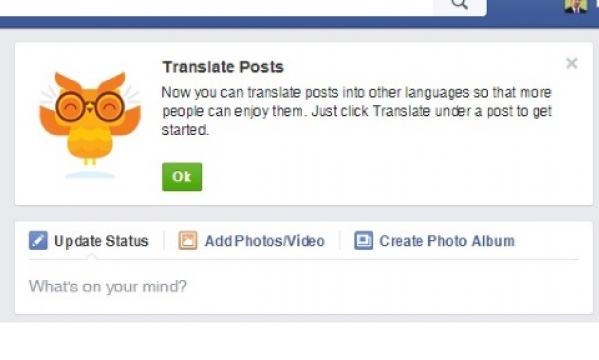 Machine to replace human translation. However, it is still a long way to go. (Image via Adweek)
Machine to replace human translation. However, it is still a long way to go. (Image via Adweek)
Facebook uses mathematics to enhance translations
American social media platform, Facebook, sought to improve its translation system to reach out to people all around the world. It is not only Facebook but also all tech giants around the globe, wanting to get their contents delivered according to their customers’ native tongue.While machine translation was found based on the dictionaries, researchers on Facebook went all science to deliver Facebook content comprehensible on a universal scale. By changing words into figures and statistics, the researchers look for mathematical similarities between languages.
All along, Facebook’s automatic translation compares parallel texts between languages to seek for its similarities and delivers the meaning. However, for some language pairs, the parallel text alone is insufficient.
Antoine Bordes, European co-director of AI research for Facebook in one of its research labs in Paris, said that Facebook had already known 200 languages. Currently, Facebook is developing a system that produces renders words into a mathematical representation.
Mathematically speaking, a word is rendered into a vector in dimensions. If words – as vectors – have a close relation to other words in the dimension, they will stick close together, explained one of the system designers, Guillaume Lample.
Giving the example, “cat” or “dog” will stick together under the “Animal” dimension. These dimensions then will be linked to each other by the algorithm.
Lample and Bordes, of course, did not promise that it would be perfect in one trial. However, as Facebook accepts many inputs, the algorithm and dimensions will be improved until reaching margin error, or no error.
Grading from the worst to the best word vector system, English – Romanian translation is the worst. While for English – Urdu, the system is the most superior to all.
Therefore, with the new findings, Facebook hopes to revive some dead languages. However, the problem is that to revive the dead language with the word vector system a large amount of reference texts is needed. We are not talking about hundreds, but hundreds of thousands, said Lample.
Source: https://bit.ly/2MAUBOe
 English
English Japan
Japan

plaquenil treatment plaquenil generic name cost can plaquenil mask lab results how good is plaquenil for diabetes
erectile dysfunction prescription buy vigora 100 mg in canada viagra use cdc safe sex practices took too much viagra stopping lipitor side effects
ivermectin dog dosage ivermectin goodrx ivermectin paste 1.87 dosage for dogs how long does ivermectin keep working
neurontin dangers gabapentin 500 mg price why neurontin for fibromyalgia? how long does gabapentin last in your system
lasix renogram water pill lasix side effects bumetanide and furosemide which one is preferred
modafinil mike buy modafinil in the us how much to sell modafinil
cvs coupons viagra otc common medications for autism fedex overnight service diet suppressant pills pain meds without written prescription compra viagra best supplement for women's libido uses for grapefruit skin viagra on line trulicity patient assistance program pdf minimum dose of viagra thailand drug store super p force viagra viagra cock prescription pill identification vitamin d libido benefits cialis viagra no 7 serum at walmart lilly pharmaceutical patient assistance generic viagra safe pharmacy humalog insulin savings card natural viagra foods class action settlements claims generic viagra & cialis cheap viagra viagra pricing at walmart dose of sildenafil for pulmonary hypertension strongest viagra pill storage of trulicity pen fda approved diet medication
modafinil teeth buy provigil near me where to buy provigil in australia provigil made by who
uses of neurontin gabapentin discount coupon neurontin causing pain in my jaw gabapentin 300 mg what is it used for
dapoxetine steroidsourcetalk priligy and xyrem interactions where can you buy dapoxetine not online
prednisone medscape prednisone 20 mg can i take tylenol while on prednisone how to take prednisone 20mg for 5 days
azithromycin for strep azithromycin 500mg pills does zithromax cure gonorrhea and chlamydia how long does azithromycin stay in your body
men's clinic for erectile dysfunction improve male libido viagra walmart viagra activate drugs that increase female libido what stores take competitors coupons
furosemide tabs buy furosemide tablets online uk is lasix a potassium sparing diuretic a nurse is caring for a client who is taking furosemide
health benefits of eating grapefruit ageless ultramax gold reviews canadian trust pharmacy viagra tablets australia valium and grapefruit juice dangers strongest prescription weight loss pills
plaquenil used for online pharmacy where can i buy plaquenil what pain meds can you take while on plaquenil
ivermectin for rats ivermectin 3 mg tabs horse ivermectin paste for dogs how long before ivermectin expires
cialis dapoxetine generic priligy 30mg buy online tadalafil 20mg + dapoxetine 30mg in india priligy where to buy reddit
viagra effects on women injectable erectile dysfunction medication seed packet wedding favors homemade viagra medication that lowers libido viral x